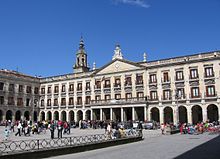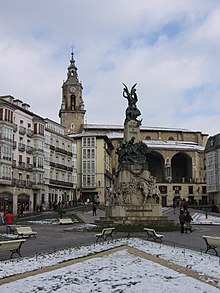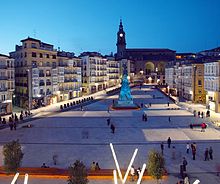Vitoria-Gasteiz
| Vitoria-Gasteiz | ||
|---|---|---|
 Vitoria-Gasteiz from a bird's eye view
|
||
| coat of arms | Map of Spain | |

|
|
|
| Basic data | ||
| Autonomous Community : |
|
|
| Province : | Álava | |
| Coordinates | 42 ° 51 ′ N , 2 ° 40 ′ W | |
| Height : | 525 msnm | |
| Area : | 276.81 km² | |
| Residents : | 251,774 (Jan 1, 2019) | |
| Population density : | 909.56 inhabitants / km² | |
| Postal code : | 01001-01015 | |
| Municipality number ( INE ): | 01059 | |
| administration | ||
| Mayor : | Gorka Urtaran Agirre ( EAJ-PNV ) | |
| Address of the municipal administration: | Plaza España, S / N Vitoria-Gasteiz, Spain Tel .: +34 945 16 16 16 | |
| Website : | vitoria-gasteiz.org | |
| Location of the city | ||

|
||
Vitoria-Gasteiz [ biˈtoɾja gasˈteis or in the middle of the sentence β -] ( Spanish Vitoria biˈtoɾja , Basque Gasteiz ɡas̺teis̻ ; the official name of the city is the compound double form Vitoria-Gasteiz ) is the capital of the Spanish Autonomous Region of the Basque Country and the province of Araba (Spanish Álava ). It has 251,774 inhabitants (as of 2019), the majority of whom are Spanish-speaking.
geography
Vitoria-Gasteiz is located in the middle of the Alavesian plateau ( Llanada Alavesa ) at about 525 m above sea level at 2 ° 0 'west longitude and 42 ° 51' north latitude. The mountains near the city have heights of around 1000 m. The Zadorra River flows through Vitoria .
The climate represents a transition from the damp, mild maritime coastal climate to the dry continental climate of the Castilian plateau . Because of the significant temperature difference, Vitoria is jokingly referred to as Siberia-Gasteiz by the inhabitants of the coastal areas . The annual average temperature is approx. 11.5 ° C, the annual amount of precipitation approx. 820 mm.
history
The King of the Visigoths, Leovigild , founded a city called Victoriacum ("Victory City ") on the occasion of a victory over the Basques in the 6th century . In 1181, King Sancho the Wise of Navarre founded the present-day city of Vitoria with the name Nueva Victoria ("New Victory"). This involved the expansion of the already existing Basque settlement of Gasteiz , which was turned into a fortification against Castile . The name of this settlement, probably a patronymic formation from Gastea , probably goes back to the personal name Garcia . The old town of Vitoria is still located on the site of the predecessor settlement Gasteiz, located on a hill in the middle of the Alavesian plateau.
In the course of history, Vitoria moved from Navarre to Castile. In 1367 the Black Prince won a victory over Henry of Trastámara for Peter the Cruel of Castile . In 1431 Vitoria was by Johann II. Of Castile , the city charter granted.
In the 16th and 17th centuries, Vitoria was a so-called puerto seco ("dry harbor"), as the customs border ran not on the coast but between the Basque provinces and the rest of Castile . There the duty was levied on the export of wool, leather and flax to Flanders and England and on the import of processed textiles from the named countries (linen, cotton and woolen cloth, silk) as well as hardware from Bizkaia . In the 18th century, during the crisis under the last Habsburgs and the War of Spanish Succession , this system fell into disrepair. Under the Bourbons, the customs border was definitely moved to the coast.
On 21 June 1813 won Wellington over Joseph Bonaparte in the Battle of Vitoria , which is a major defeat for the French during the Napoleonic Wars meant.
In contrast to the two more northern Basque provinces, where industrialization began very early in the late 18th century, Álava was mainly characterized by agriculture. Vitoria was a rather sleepy provincial town with a very high population of clergy and military personnel, in which the townscape was dominated by monasteries and barracks. On the other hand, the majority of the population was literate as early as the 19th century and the language border between Basque and Spanish had shifted to the northern mountain ranges, which represent the border between the Llanada and the coastal valleys.
During the civil wars of the 19th century, Vitoria was a liberal bulwark and was besieged for a long period without success by the Carlist , who were well represented in the rural districts of the province, but not in the capital.
In 1936, due to the strong military presence, right at the beginning of the coup against the democratic republic, the city fell to the "national", Francoist side. The newly proclaimed Basque Republic tried to retake Vitoria, but its troops failed in the Battle of Villarreal, the only major offensive by the Basque Republican army.
For a time, forces from Hitler's Condor Legion were stationed in Vitoria and started the air raid on Gernika from here .
Due to the fact that she was on the winning side, Álava, like Navarre, was allowed to keep the old Basque special rights ( Fueros ) that were withdrawn from Biscay and Gipuzkoa by the winners. The clever use of these special rights led to strong economic growth and significant population growth in the post-war years. Until the civil war , Vitoria was mainly an administrative center with a low economic weight, after which it developed into an important industrial center. In just a few decades, the population rose from almost 30,000 to over 200,000. The increase was based in part on regional rural exodus . However, there were also many immigrants from Andalusia and Extremadura who were discriminated against in the first few years with the despective nicknames Coreanos and Maketos .
Since 1980, Vitoria-Gasteiz has been the capital of the Spanish Basque Country. The choice of Vitoria was made deliberately in order to tie Álava, who wavered between Spanish and Basque loyalty, more closely to the Basque Country. Since Vitoria became the capital of the Basque Country, the city has attracted many new residents, including many officials from the Basque government.
politics
Mayor of the city has been Gorka Urtaran Agirre (EAJ / PNV) since June 13, 2015.
Results of the 2015 local elections:
| Party / list | Seats |
|---|---|
| PP | 9 seats |
| Bildu | 6 seats |
| EAJ / PNV | 5 seats |
| PSE-EE / PSOE | 4 seats |
| Sumando | 2 seats |
| Irabazi | 1 seat |
| total | 27 seats |
Culture and sights
Individual structures
- Santa María Cathedral (“Catedral Vieja”): built in the 13th and 14th centuries in Gothic style. The building was part of the city's fortress wall in the Middle Ages and inspired the British writer Ken Follett to write his novel The Gates of the World in 2007 .
- María Inmaculada Cathedral ("Catedral Nueva"), neo-Gothic
- El Portalón : Former hostel from the 15th century and one of the oldest houses in the city. The emblematic building is now used as a restaurant.
- Palacio de Villa Suso : Late Gothic city palace from the 16th century on the Plaza del Machete , where the king's representative swore to observe the fueros.
Places
- Plaza de la Virgen Blanca , monument to the battle of Vitoria
- Plaza de España (also called Plaza Nueva ), Spanish square in the style of the Plaza Mayor in Madrid , rectangular with an archway from the 18th century
- Plaza de los Fueros , co-designed by Eduardo Chillida
- Parque de El Prado , in 2002 the light artist Claudia Wissmann installed her multi-part work Light-Gardens there . The installation is public and permanently accessible.
Streets and neighborhoods
- Calle Dato , pedestrian zone, shopping and promenade street with cafeterias, shops and banks; 19th century townhouses
- Ensanche, shopping streets and business center around Calle Dato
- Old town, medieval town houses, towers and fortifications
- Avenida Gasteiz , the main artery in the west of the city, with the Palace of Justice, Congress Palace and important hotels
Museums
- Artium , Basque Museum of Modern Art
- Playing card museum "Fournier"
- Natural Science Museum
- Arms Museum
- Heraldry Museum
- Archaeological Museum
The Alava dolmens are near the village
Government and administration buildings
- Ajuria Enea , residence of the Lehendakari (Basque Prime Minister)
- Lehendakaritza , seat of government of the same
- Basque Government ( Gobierno Vasco )
- Basque Parliament
- Government of Alava ( Diputación )
gastronomy
The gastronomy in Vitoria has few specialties of its own, but this in no way affects the quality and variety of the dishes. On the one hand, many Basque meals are prepared, but there is also a clear influence of the nearby regions of Castile and La Rioja ( lamb , grilled meat). Pinchos are served in many restaurants in the city center . Special specialties are prepared for certain occasions, e.g. B. Peretxikos (a type of mushroom) in autumn and snails on the holiday of San Prudencio , the patron saint of the province.
Among the desserts, Goxua should be highlighted, a caramel- coated pudding with a layer of cream and a layer of cake batter.
The pastries and pralines from Vitoria also have a good reputation.
Red wine from the Rioja wine-growing regions ( Rioja Alavesa and Rioja Alta ) is offered at a high level in the city's restaurants. Vitoria has a remarkable number of first class restaurants.
Events
The international Jazz Festival Vitoria-Gasteiz has been held in July since 1977 . Since 2006, the annual Kaldearte street theater festival has been held in June .
Population development of the municipality
Economy and Infrastructure
economy
Vitoria-Gasteiz is home to industrial companies in the automotive, mechanical engineering, aeronautical and playing card production sectors.
Significant companies are:
- Vitoria plant of Mercedes-Benz Espana SA in the Mercedes-Benz Cars division of Daimler AG : Production of the Mercedes-Benz "Vito" and "V-Class" models
- Michelin : car tires
- Gamesa Corporación Tecnológica : wind turbines
- Gamesa Aeronáutica: aircraft parts
- Fournier: playing card factory
- Aernnova Aerospace SA
- Loramendi: foundry technology
In October 2010 Vitoria-Gasteiz became the third European city to be awarded the title of European Green Capital for 2012.
traffic
The city traditionally has a foot traffic share of around 50%; Between 2005 and 2015, Vitoria-Gasteiz was able to increase the proportion of cyclists from 3.4 to 12.3%: in 2008, parked cars blocked 64% of the streets and squares in the city. With the adoption of a “Sustainable Mobility Plan” in the same year, cars should only be allowed 15 to 20% of the public road space with a consequent renovation of the infrastructure, the remaining area should be shared by cyclists and pedestrians. The city is part of the European Biking Cities association of six European cities.
Since December 2008, is tram society EuskoTran in operation, the first line of the city center with the district Lakua connects. Another line leads to the Abetxuko district .
Vitoria is very well connected to the Spanish road network via the A-1 (formerly N I, main motorway connection Madrid- Irun - France ) and via the AP-68 (to Bilbao ). The AP-1 Vitoria - Eibar motorway section has been in operation since 2009.
The Madrid-Irun-France railway line runs through Vitoria and the Miranda de Ebro railway junction is around 35 km away.
Vitoria-Gasteiz has Foronda Airport , which is of little importance for passenger traffic, but is the most important freight airport in the Basque Country.
The port of Bilbao ( Santurtzi , Zierbena ) is around 60 km from Vitoria and can be reached directly via the AP-68 and the A-8.
Education
The University of the Basque Country (UPV, Universidad del País Vasco ) is spread over the three Basque provincial capitals Bilbao, San Sebastián and Vitoria. 7,445 students study in Vitoria (as of 2003). The main fields of study at UPV Vitoria are pharmacy , philology , geography , history and engineering . The university buildings are partly former military buildings. But the library is very old.
Sports
- The football club Deportivo Alavés is at home in the Mendizorrotza stadium .
- The home arena of the Saski Baskonia basketball club is the Fernando Buesa Arena (formerly Araba Arena).
Town twinning
Vitoria-Gasteiz has partnered cities with the following cities, among others :
-
 Georgia : Kutaisi
Georgia : Kutaisi
-
 France : Angoulême
France : Angoulême
-
 Brazil : Vitória , State of Espírito Santo
Brazil : Vitória , State of Espírito Santo -
 United States : Victoria , Texas
United States : Victoria , Texas -
 United States : Anaheim , California
United States : Anaheim , California -
 Equatorial Guinea : Cogo
Equatorial Guinea : Cogo
sons and daughters of the town
- Miguel Ricardo de Álava (1771–1843), general and diplomat
- Mateo Benigno de Moraza (1817–1878), politician, lawyer and advocate of the Fueros
- Sebastián Iradier (1809–1865), Sebastián de Iradier y Salaverri, composer
- Manuel Iradier (1854–1911), explorer
- Ramiro de Maeztu (1875–1936), journalist and literary critic
- José María Larrauri Lafuente (1918–2008), Bishop of Vitoria-Gasteiz
- Alberto Schommer (1928–2015), photographer
- Juanito Oiarzabal (* 1956), extreme mountaineer, conqueror of the 14 eight-thousanders
- Andoni Zubizarreta (* 1961), soccer goalkeeper
- Martín Fiz (* 1963), marathon runner
- Pablo Laso (* 1967), basketball player and coach
- Justo Ruiz (* 1969), football player
- Koldo Álvarez (* 1970), football goalkeeper
- David Martínez De Aguirre Guinea (* 1970), religious and bishop
- Javier Maroto (* 1972), politician
- Igor González de Galdeano (* 1973), racing cyclist
- Pablo Martín Caminero (* 1974), jazz musician
- Eneko Pou (* 1974), climber
- Eneko Llanos (* 1976), triathlete
- Aitor Ocio (* 1976), football player
- Iker Iturbe (* 1976), basketball player
- Maider Unda González de Audicana (* 1977), wrestler
- Iker Pou (* 1977), climber
- Unax Ugalde (* 1978), actor
- Iker Romero Fernández (* 1980), handball player
- Koldo Fernández (* 1981), racing cyclist
- Álex Ubago (* 1981), singer
- Ricardo García (* 1988), racing cyclist
- Tania Calvo Barbero (* 1992), track cyclist
- Mikel Landa (* 1989), racing cyclist
- Pedro Astray (* 1992), football player
Web links
- http://www.vitoria-gasteiz.org/ City administration
Individual evidence
- ↑ Cifras oficiales de población resultantes de la revisión del Padrón municipal a 1 de enero . Population statistics from the Instituto Nacional de Estadística (population update).
- ^ Resultados de las elecciones municipales en Vitoria (2015)
- ↑ Resultados de las elecciones municipales en Vitoria (2015) , accessed on October 13, 2016
- ↑ Light windows and light boxes, In: Stadtlicht, Lichtkunst, Christoph Brockhaus (editor), Wienand Verlag: Cologne, 2004, ISBN 3-89279-604-1 , p. 122.
- ↑ cleanair-europe.org: "European Biking Cities" - Cycling for clean air (April 14, 2017)
- ↑ blog. zeit.de , August 14, 2015, Andrea Reidl: With the clear will for more bicycle traffic (April 14, 2017)
- ^ City website , accessed October 13, 2016
← Previous location: Agurain | Vitoria-Gasteiz | Next town: La Puebla de Arganzón →












